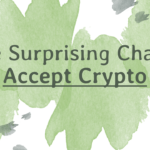You may have heard of an ‘up and coming’ competitor to Ethereum lately, but if not, 2022 could be a great time to start researching in Solana. ‘Layer 2 blockchain solutions’ and ‘Web 3’ have been getting a lot of buzz around social media but what’s it all about?
Investment strategist Raoul Pal actually compared the parabolic growth of Solana with Ethereum in 2018. He made a chart that showed that we may be seeing a similar growth pattern in Solana.
But what exactly is Solana and why is it considered a long-term rival to Ethereum? Crypto nerds throw around jargon like layer 2 blockchain and the normal folks are left scratching their chin…
Contents
#1 What makes Solana it different from other Blockchains?
What makes SOL different?
Basically, Solana claims to be the fastest network (although this might not actually true). It currently boasts 400 millisecond block times and low fees. In layman's terms, this makes it SUPER fast. Take Ethereum, for example, which only has a 10 second block time, or Bitcoin's 10 minutes.
It claims to support 710,000 transactions per second, which is about 30x more than Visa which can handle 23,666 transactions. The devil here is actually in the details: the time to finality is less than Avalanche, but that might not actually matter. Solana is fast and cheap, comparable to the Matic network with fees as low as 1/100th of a penny.
Ethereum's gas price is notoriously high. Solana users can breathe a sigh of relief because transaction fees will always remain under a penny thanks to an excellent scaling solution, even if the network becomes very stressed.
Infrastructure projects(blockchains) tend to do really well, historically.
This could make Solana a very attractive project to keep an eye on for both big institutions and the little guys like us. Key word is, could.
#2 Solana Consensus mechanism
Consensus mechanism is a fancy term to describe how a transaction is verified. Bitcoin uses proof of work, meaning computers basically need to solve complex math equations and melt the inside of your house in order to mine bitcoin.
Solana is a lot more environmentally friendly, as it uses a combination of proof of stake with a unique consensus model called 'proof of history'.
Proof of history works by integrating time into the blockchain data. In short, each of the validators knows their order without having to communicate back and forth. It's kind of like being assigned a specific job at a factory without having to see exactly which job has been done. This lessened communication requirement directly translates into a much faster network. Henry Ford would be proud...
We often take time for granted, but computers have to constantly ask themselves 'What time is it?' since they can't look at their phone or look at the sun, they rely on nodes to do this before submitting a block.
One analogy we can use:
Suppose you were making a video about how to cook chocolate cake. There's 5 steps to making chocolate cake, so you assign 5 video editors each with their own step. We want to read the steps in order once the editors submit them, but they are each working from different time zones so you're not sure when each step will be sent. The clips might not all arrive at the same time(different delivery times) but you can organize the steps once you get them. By not asking each video editor to check whether the last steps have been done before theirs, it saves time.
#3 Who created it?
Solana's original whitepaper was published in 2017 by Anatoly Yakovenko. Anatoly designed compression algorithms for Qualcomm in the last decade as well as Dropbox.
Like many software geeks, he's not super public, preferring to maintain his privacy. We did find out he was a world class underwater hockey player, though(no, seriously, it's on his blog: https://medium.com/@anatolyyakovenko) but otherwise seems like your standard smart fella in tech.
He might not be as interesting as our boy Vitalik (and don't ask us why he doesn't comb the middle of his hair) but we still are intrigued by him here at Cryptogiggle.
#4 Other benefits
One of the other benefits Solana offers is that there is no requirements to become a validator. In Ethereum 2.0 you need to stake 32 ethereum or roughly $100,000. For Solana, you need to pay a small fee to vote but you need very little Solana to stake it.
They aren't bottlenecked by software issues. The website reads "Every tiome Nvidia doubles the number of SIMD lanes available, our network will double in computational capacity".
Unlike Ethereum and a lot of others blockchains, you can't copy/paste code from other dApps to run on Solana. Solana uses RUST which is a lower-level programming language. This makes it harder to develop on but also gives more power and possibility to do different things.
Similar to Avalanche, Solana is both inflationary and deflationary. It's deflationary because for the longest time, 100% of all transactions were burned. Now, it's 50%. But it's inflationary because it pays staking rewards at 8%. Eventually the reward cut until they hit 1.5% in 10 years.
Basically, every time the coin is transacted (sent or received) the supply of coins shrinks, theoretically making it more valuable each and every transaction and this is offset by the value-reducing staking ability - "balance to the force, this brings!" - Yoda...maybe..
#5 Who’s talking about it?
Because Solana is harder to develop applications on, adoption is going to be a bit slower. It's not a simple port of Ethereum, though, so as the number of dApps built on Solana grows, it has the potential to scale into something much better than Etheruem.
Nevertheless, some celebrities have taken an active interest in Solana and Twitter is pretty excited. In December 2021, former first Lady Melania Trump announced plans to launch an NFT on Solana. Solana foundation was quick to disassociate itself to stay politically neutral. Just in case you were interested, it was available from December 16 till the 31st and the project is titled 'Melania's vision'.
Other projects include a decentralized exchange known as Serum, a derivatives platform called Mango, and Tulip Protocol, which is a yield farming aggregator using auto-compounding strategies.
------------------------------------
Do you think Salano will be the "Ethereum killer" it is touted as on social media? Will it flip Ethereum? Hard to say, but this is surely one project to keep an eye on.









Comments
Loading…